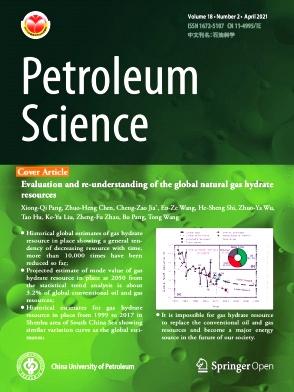A high-efficiency Q-compensated pure-viscoacoustic reverse time migration for tilted transversely isotropic media
IF 6
1区 工程技术
Q2 ENERGY & FUELS
引用次数: 0
Abstract
The attenuation and anisotropy characteristics of real earth media give rise to amplitude loss and phase dispersion during seismic wave propagation. To address these effects on seismic imaging, viscoacoustic anisotropic wave equations expressed by the fractional Laplacian have been derived. However, the huge computational expense associated with multiple Fast Fourier transforms for solving these wave equations makes them unsuitable for industrial applications, especially in three dimensions. Therefore, we first derived a cost-effective pure-viscoacoustic wave equation expressed by the memory-variable in tilted transversely isotropic (TTI) media, based on the standard linear solid model. The newly derived wave equation featuring decoupled amplitude dissipation and phase dispersion terms, can be easily solved using the finite-difference method (FDM). Computational efficiency analyses demonstrate that wavefields simulated by our newly derived wave equation are more efficient compared to the previous pure-viscoacoustic TTI wave equations. The decoupling characteristics of the phase dispersion and amplitude dissipation of the proposed wave equation are illustrated in numerical tests. Additionally, we extend the newly derived wave equation to implement Q-compensated reverse time migration (RTM) in attenuating TTI media. Synthetic examples and field data test demonstrate that the proposed Q-compensated TTI RTM effectively migrate the effects of anisotropy and attenuation, providing high-quality imaging results.
求助全文
约1分钟内获得全文
求助全文
来源期刊

Petroleum Science
地学-地球化学与地球物理
CiteScore
7.70
自引率
16.10%
发文量
311
审稿时长
63 days
期刊介绍:
Petroleum Science is the only English journal in China on petroleum science and technology that is intended for professionals engaged in petroleum science research and technical applications all over the world, as well as the managerial personnel of oil companies. It covers petroleum geology, petroleum geophysics, petroleum engineering, petrochemistry & chemical engineering, petroleum mechanics, and economic management. It aims to introduce the latest results in oil industry research in China, promote cooperation in petroleum science research between China and the rest of the world, and build a bridge for scientific communication between China and the world.
 求助内容:
求助内容: 应助结果提醒方式:
应助结果提醒方式:


